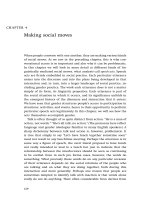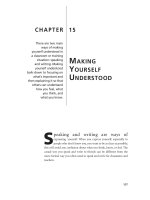Making Studying Do-able
Bạn đang xem bản rút gọn của tài liệu. Xem và tải ngay bản đầy đủ của tài liệu tại đây (73.65 KB, 10 trang )
41
CHAPTER
6
M
AKING
S
TUDYING
D
O
-
ABLE
Break up a major study
project into pieces and it
won’t seem so impossible.
Make a plan based on your
unique learning style and
stick to it. Take into
consideration how much
time you have before the
exam, how difficult the
material is for you, and
where and when you study
best. The key here is to
study “brick by brick,”
making a study project—
whether reading a long
chapter or writing a major
paper—less intimidating
and more do-able.
T
he next time you’re in a group, ask each
person how long it took them to learn to ride a bike, type, or
drive a car. Chances are you’ll have a different answer from each
person. Someone might have learned in two months, someone else in
two years, another person in two weeks—or maybe even two days!
Everyone has their own rate of learning. And it varies, depending on
what it is you’re learning. When you’re developing a time-management
study plan, you need to keep in mind how you learn.
HOW TO STUDY
42
TIME MANAGEMENT
U
SING A
C
ALENDAR
Use your calendar as a study planner. There are endless possibilities of
how to do this; find the way that works best for you. Below are a couple
of suggestions.
One Color Per Course
Use a different color ink for each course you have to study for. Record
what you’d like done when, for each course in its color, all on the same
calendar. Your calendar might end up looking like a rainbow, but you’ll
have a clearer idea of each deadline.
Set Three Deadlines
Write on the calendar the dates:
• You must have your project finished
• You’d like to have it finished
• You’d like to have it almost finished
Using multiple deadlines works especially well if you’re the type of
person who sets your clock ahead five or ten minutes. It’s always wise to
get a project finished ahead of time because, like Murphy’s Law, if some-
thing can go wrong, it will. If you often have to put in overtime at your
job, or have fluctuating family responsibilities, set your “almost finished”
deadline at least two weeks before your final deadline. Staying on top of
a project, be it studying for a big exam, writing a paper, or completing a
major lab report, will give you the sense of control you need to study
effectively.
Divide a Task into Smaller Steps
Big tasks can be broken up into small stages, each with its own deadline.
For example, if your assignment is to read a book and then write a report
about it, you could set up four stages for the project:
1.
Read the book, taking notes as you go;
2.
Review your notes and prepare questions for your report
3.
Write a draft of your report
4.
Edit and polish the report into finished form.
MAKING STUDYING DO
-
ABLE
43
Set a separate deadline for each stage by breaking up the time
between now and the report’s due date. Allocate less time for the easier
stages and more for tougher ones.
If, after you’ve thought it all through, you see that you would work
better if there were even more steps with more interim (in-between)
deadlines, add them in. For instance, you might want to divide both your
reading and writing the rough draft into two steps each.
D
EALING WITH
D
EADLINES
If You Work Well with Deadlines
Arrange to meet with a friend or study buddy at least every two weeks, or
once a week if you can. During your meetings, show and explain to your
partner what you’ve done since you last met. Having someone else keep
track of your progress will provide outside pressure, encouraging you to
keep up with your deadlines. (Chapter 16, “Working with Your Study
Buddy,” will go into this in more detail.)
If Deadlines Make You Nervous
Give yourself plenty of time! Working steadily and regularly prevents
last-minute pressure. You’ll find tips on how to do this in Chapter 1,
“Getting Started.” Do what it takes to keep calm and cool—even if it
means reading or writing in the bathtub!
Juggling Several Projects at Once
What if you have more than one study project due at the same time?
Think of it as building all the walls of your house, a bit at a time, so the
four walls will be finished together. Start the more complicated project,
or the more challenging subject immediately. Give it 20 minutes at a
time, more or less, depending on your learning tempo. Weave in study
time for the other subjects, using one as a study break from the others.
Devote smaller amounts of time to simpler projects, but be careful not to
neglect them entirely.
M
AKING
T
IME
You want to make the most of the time of day that works best for you,
particularly if you’re learning something new. But you can also make
good use of less optimal times during your day. Remember, every little bit
HOW TO STUDY
44
counts. Six study periods of ten minutes each make a total of one full
hour. Try any of the following times in your day-to-day schedule to see
which of them work for you.
While Showering or Working Out
Perhaps a good time to study is the time you have to yourself while you’re
in the shower, or running, walking, or doing other exercise. With few
other distractions, you can be thinking about what you’ve recently read or
learned in a class. Consider it your physical—and mental—tune-up time.
On Your Way to Work or Class
If you take a bus, train, or ferry, you can listen to tapes on a headset or read
and write in your notebook or reading log. (See Chapter 10, “Getting
More Out of Reading,” for creating and working with reading logs.) If you
drive, you can listen to a tape (but not a headset—you might not be able
to hear an emergency vehicle), or you can be thinking about something
you’ve read recently.
At Lunch
This can be a good time to read and write in your reading log. If you rou-
tinely lunch with others, excuse yourself early or reserve a couple of
lunchtimes a week for some studying.
While Doing Chores
Household chores occupy your hands, but free your mind—and ears—
for thinking, talking (even if it’s to yourself!), and listening to tapes. For
example:
• If you learn best by hearing: You can listen to a taped lecture,
notes you recorded on audiotape, or a book on tape while you
wash dishes.
• If you learn best by doing: You might want to go back and
forth, spending 10 to 20 minutes on reading and/or writing,
then 10 to 20 minutes on meal preparation, and so on.
At Bedtime
You are most apt to remember something when you are very relaxed, so
bedtime can be ideal study time—so long as you’re not dead tired.
MAKING STUDYING DO
-
ABLE
45
Change your routine so that you get to bed about half an hour earlier
than usual. Read something you want to remember for 20 minutes or less
just before you go to sleep. Or listen to a tape, if you learn best by hear-
ing. Your subconscious will hold onto what you read or heard while you
sleep. Read or listen to the same material again right after you wake up.
Remember to use the learning styles—reading aloud, drawing pictures—
that work best for you.
You can also use this technique if you are trying to come up with an
idea or a solution. Pose the question to yourself just before going to sleep.
Chances are, you’ll wake up with an answer!
T
HE
R
IGHT
T
IME FOR THE
R
IGHT
T
ASK
Two of the most important phases of studying are absorbing new material
and reviewing old. It is important to perform these tasks when you’re at
your best. Making connections is also essential in the learning process; you
can make connections any time of day.
Learning New Material
New material will be absorbed more readily if you study when you’re
comfortable and your mind is fresh. Try getting up a little earlier than
usual in the morning to study while you have fewer distractions.
New material stays in a certain part of your brain—a kind of hold-
ing area—for only three days or so. To ensure that you cement it more
permanently in your memory, review the material as soon as possible.
Reviewing Old and New Material
Reviewing new material is less challenging than learning it in the first
place, but still takes lots of “brain energy.” Before and after sleep are good
times for review. Make sure you use your learning styles (see Chapters 2
through 5).
Reviewing old material is just as important, especially when you’re
studying for a final exam that covers topics from the beginning of the
year. It’s easy to say, “I don’t need to review; I’ve already studied it once.”
But your brain needs a refresher course. Reviewing old material regular-
ly in small bits is much more effective, and less hectic, than trying to
review everything the night before the test.









